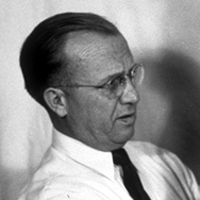Success Starts Here
Your gateway to the Library Catalog, Digital Items, Library Website search results, and more simultaneously!
Your gateway to the Library Catalog, Digital Items, Library Website search results, and more simultaneously!


Hughes Curtis was born in Springville, Utah in 1904. Primarily a self-taught sculptor, he was part of the ongoing tradition of the realistic school of western American sculpture. He died in 1972.
Curtis lost his leg in an accident when he was a boy. By the time he was nine, he had learned to carve his own crutches. He also carved wooden guns, animals, and whistles. Two famous Utah artists mentored Curtis; the sculptor Cyrus Dallin, a Springville native, and Howard Kearns, a Utah painter.
Curtis established one of the earliest bronze foundries in Utah. Two of Curtis's notable sculptures are Saddling Up (1942) featured in the Springville Museum of Art permanent collection and Rim Rock (1961).
Biographical information on this page was adapted from the Springville Museum of Art.
Hughes Curtis is one of few bronze sculptors who was primarily self-taught. His scenes of the West are inspired by his own real-life experiences. The result is art that is as individual and original as the person.
Curtis was born in a two-room adobe house in Springville, Utah, in 1919, when the town was a railroad hub and still a stranger to electricity. To be a herder or a cowboy was, out of necessity, a common lifestyle. Growing up in this rugged environment, Curtis took on a tough exterior that shaped his personality and behavior. As a boy, he and his brothers were accustomed to "hitching a ride" on the slow trains that moved through Spanish Fork Canyon. One time Hughes slipped, and his leg became tangled under a wheel and had to be cut off at the knee. Although this accident made his childhood difficult because of a lack of acceptance by others, it also caused the young Curtis to explore his artistic abilities.
Hughes' father, Val Curtis, often had to whittle new crutches for the boy. Unfortunately, Hughes was capable of breaking them as fast as his father could make them. Curtis finally threatened Hughes, saying he would have to make his own crutches if he broke this last pair, hoping it would subdue his activity. However, by the time he was nine years old, Hughes had learned to walk with only one crutch and was able to make his own. He used a hexagonal design made of solid oak and walnut. His pocket knife became his constant companion and was used to turn kindling into tiny wooden guns, animals, wagons, and whistles.
Whenever Hughes was sitting, he was carving, modeling, or sketching. While other boys were playing baseball, he sat on the river bank molding the native clay. His school notebooks and texts were full of caricatures, and he carved a platoon of toy soldiers out of the school's chalk. Hughes "admitted that had he not lost his leg, he never would have done anything about his urge to create."
Hughes Curtis was about 15 years old when he met Cyrus Dallin. Curtis had only recently been given his first commission to carve the panels of a horse-drawn hearse when the famous sculptor returned to Springville for the summer. Dallin taught Curtis how to practice carving on a yielding block of plaster, and when he realized the serious attitude of the young artist, Dallin gave him many suggestions on how to improve. Before long, Hughes began modeling clay. Dallin showed him how to support his figures internally with armatures. When Hughes understood the personality of clay, how to keep it from drying, how to keep it from getting too moist, and the ease and pliability of the native clay, he immediately abandoned his first love of wood carving.
Over time and with more help from Dallin, Hughes learned the piece-mold method of sculpture and enjoyed the new freedoms clay allowed. However, Hughes hoped to be able to attend art school and travel to Paris like Dallin and Hafen had done. He devised a plan to work as a barber and earn money to pay for school. Unfortunately, the Depression deterred his plan and kept his dream out of sight.
Hughes Curtis' good friend Howard Kearns had been able to afford art school. He sent his books home from the California Arts School for Hughes to borrow. Whenever Howard was home from school, the two friends were inseparable and often went on "art excursions." Howard painted or sketched and Hughes gained inspiration for his next sculpture through watching scenes of Indians and ranchers, western life. Saddling Up (1942), is an example of the candid scenes they encountered.
Biography courtesy Springville Museum of Art.
Books
Olpin, Robert S., William C. Seifrit, and Vern G. Swanson. Artists of Utah. Salt Lake City, UT: Gibbs Smith Publisher, 1999.
Swanson, Vern G., Robert S. Olpin, and William C. Seifrit. Utah Painting and Sculpture. Layton, UT: Gibbs Smith Publisher, 1991.
Swanson, Vern G., Robert S. Olpin, Donna Poulton, and Janie Rogers. 150 Years Survey of Utah Art, Utah Artists. Layton, UT: Gibbs Smith Publisher, 2001.